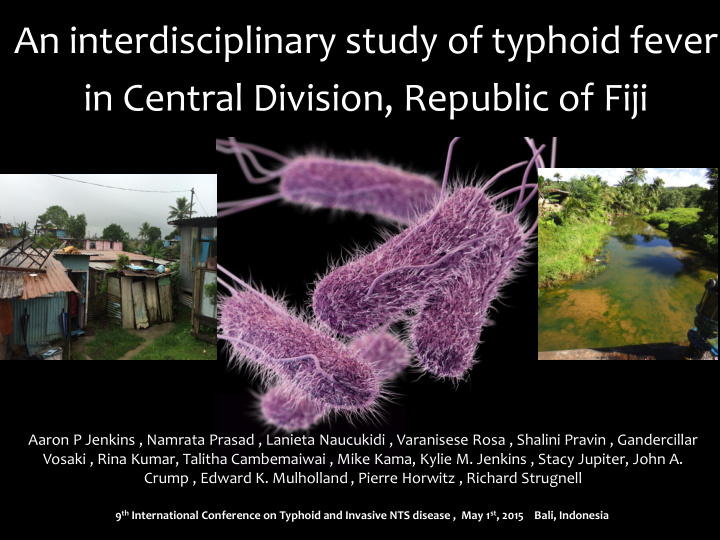



An interdisciplinary study of typhoid fever in Central Division, Republic of Fiji Aaron P Jenkins , Namrata Prasad , Lanieta Naucukidi , Varanisese Rosa , Shalini Pravin , Gandercillar Vosaki , Rina Kumar, Talitha Cambemaiwai , Mike Kama, Kylie M. Jenkins , Stacy Jupiter, John A. Crump , Edward K. Mulholland , Pierre Horwitz , Richard Strugnell 9 th International Conference on Typhoid and Invasive NTS disease , May 1 st , 2015 Bali, Indonesia
Outline • The study framework • Where are the cases – GIS • Case /control • Environmental investigations • Molecular detection -rPCR
Number of lab confirmed Typhoid cases 100� 150� 200� 250� 300� 350� 400� 450� 50� 0� 1991� detected by passive surveillance, Fiji, 1991 -2014 1992� 1993� Salmonella Typhi bloodstream infections 1994� 1995� 1996� 1997� 1998� 1999� 2000� 2001� 2002� 2003� 2004� 2005� 2006� 2007� Adapted from Kool et al. 2010 2008� 2009� 2010� 2011� 2012� 2013� 2014�
Primary threats to natural systems
Conceptual model of mechanisms determining health in high island river basins Cyclones & Catchment Heavy Rain Modification + + Runoff + + + Damage to Animal & Sediments Infrastructure Human Density & Nutrients + + + + Contaminated Bacterial - food & water Carriage + (eg. S. Typhi) - - Human Well-Being Food Fish & River & Sociocultural/ (Disease Burden, Invertebrates Reef Health Behaviour Nutrition & Livelihoods) Jenkins & Jupiter (2015) Wetlands Hum Health, in press Jenkins & Jupiter (2014) , in press
Interdisciplinary research elements Case control study (2014- 15): Catchment Health Index Geospatial (Typhoid epidemiology, analysis flood risk, resource (2008-2014) availability) Typhoid resurgence Is it related to aquatic resource decline? Environmental- Outcome Microbiological harvesting (water, soil) Molecular detection (rPCR & sequencing)
SUVA
Geospatial analysis of cases (2008-2014) Central Division SUVA
Geospatial analysis
Typhoid Incidence 2013
Typhoid Incidence 2014
Rural high incidence setting
Urban high incidence setting
Geospatial distribution of cases (2013-2014)
Potential landscape/temporal predictors : • Forest cover • Road density • # River crossings • Level of cultivation • Relative Erosion Potential • Rainfall
Environmental sampling • Water – stored, source, nearby stream • Soil – toilet, toilet drain, household garden • On site – Temp, pH, conductivity, DO • Lab process – Total Coliforms, E.coli • Filtered (0.4 microns) – stored for PCR • Filtrate – Nitrates, Phosphates, Ammonia
Mean Most Probable Number of Escherichia coli in water & soil of cases & controls WATER 10000 Cases Controls Mean Most Probable Number E.coli / 100ml +/- se 1000 * * Safe swimming 100 14 21 16 10 22 44 30 Safe drinking/eating 1 Stored Source Near Stream SOIL 10000 1000 100 12 15 23 45 21 45 10 1 Toilet Toilet Drain House Garden
RURAL URBAN
Total Coliforms and Escherichia coli in Rural vs Urban Drinking Water Mean Most Probable Number CFUs / 100ml +/- se 800 * 700 600 * 500 Total Coliforms E.coli 400 300 2 6 46 * 200 * 44 100 2 6 61 44 46 61 0 Rural Urban Rural Urban Stored Source
Mean concentration of nutrients in water & soil of cases & controls * 4 3.5 3 2.5 Case Mean concentration (mg/L) +/- se 2 WATER Control 1.5 1 0.5 0 Phosphate Nitrate Ammonia * 8 7 Case 6 Control 5 4 SOIL 3 2 1 0 Phosphate Nitrate Ammonia
Molecular detection • rPCR on water & soil samples • Assay works in soil…a first? • 5 positives from 50 samples – all case houses
Muddy water below house entrance
Conclusions • In endemic, high-incidence, flood prone settings environmental sources of exposure are likely • Localized behaviors, household environments or river basin settings may enhance risk of typhoid • Focus on natural and built infrastructure + vaccination • Pacific Islands as model systems for typhoid control and elimination?
Said Lao Tsu, 2,500 years ago. “Thirty spokes share the wheel’s hub; It is the center hole that makes it useful .”
THANK YOU a.jenkins@ecu.edu.au
Recommend
More recommend